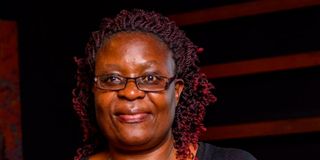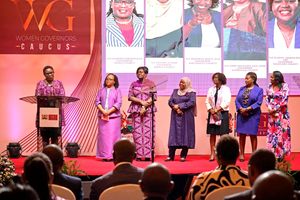Pamela Savai’s journey through cervical cancer treatment

Pamela Savai, a cervical cancer survivor who lost her womb to the disease.
What you need to know:
- HPV vaccine has been fronted as a primary prevention intervention for cervical cancer control.
- Experts say it prevents infection with HPV types that cause most cervical cancers.
Pamela Savai never imagined her life would take such a dramatic turn. She had always been healthy and active. But in January 2019, during Cervical Cancer Awareness Month, everything changed.
What started as a random screening at Uhuru Park, a recreational park in Nairobi quickly turned into a nightmare.
While lying on the examination table, the doctors noticed something unusual, a growth on her cervix. They immediately sent her for a pap smear. She remembers going home feeling unsettled, her mind racing with fear and uncertainty.
The Pap smear led to further tests, including a colposcopy—a closer examination of the cervix—and eventually, a biopsy. The results came back with devastating news: Pamela was in the early stages of cervical cancer.
The diagnosis struck fear deep into her heart stirring painful memories of her family's battle with cancer. Just three years earlier, in May 2016, her maternal uncle lost his fight with colon cancer. Now, she found herself facing the same deadly disease.
But what terrified her even more was the thought of leaving her children behind. As a widow, the idea of her children growing up without either parent was unbearable.
“The diagnosis broke me down. I was shocked and devastated. I saw death staring at me. I completely lost hope of living and had moments whereby I would just cry for like two months,” she recalls.
Then came the devastating news that she would need a hysterectomy, her emotions already raw from the financial burden of the treatment. However, despite the overwhelming challenges, she found a glimmer of hope in the thought that this surgery could ultimately save her life.
“Since I already had two children, I didn’t mind losing the womb. What mattered was my life,” she explains.
Her journey to finding better treatment was fraught with challenges. Public hospitals were fully booked to the point of being overwhelmed, and conducting tests took unnecessarily longer. Some were also hesitant to conduct biopsies, yet time was ticking.
Eventually, she visited a private hospital, which conducted the required tests, and called her in for results within two months. Indeed, she had cervical cancer.
“ On April 29, 2019, I was wheeled into the theatre for a five-hour surgery. A biopsy conducted immediately after showed that the cancer had not spread. My doctor also said they had removed all affected cells,” recalls Ms Savai.
“I was discharged from the hospital after five days and was fully recovered in six weeks. I then started my monthly checkups. Gradually, this changed and I started going for tests every three months, then six months, then annually.. All my tests since the surgery have shown that I am cancer-free,” she adds.
Through my experience, I learnt that cervical cancer is caused by the HPV virus—it can be screened for, treated, and even prevented with the HPV vaccine for young girls aged nine to 15. No woman should die from cervical cancer.” Post-surgery, she adopted a healthier lifestyle, finding solace in physical activity.
Pamela’s experience has profoundly shaped her views on women’s health and reproductive rights. During the Covid-19 pandemic, she joined Kilele Health, a support group for survivors and caregivers of people living with chronic conditions.
“In this group, we support one another psychologically, and we go for hikes to keep our bodies fit during and after treatment. The journey is much easier with people you resonate with,” explains Pamela.
“I thank God for giving me another chance. Being alive is my greatest victory in this cancer journey. Regular screening is paramount; early screening saved my life.Because it was detected early, the cost of treatment was lower, and the damage to my body was minimal,” she adds.
Pamela was lucky to have an early screening but thousands of women miss out of early detection of cervical cancer.
Health experts are now calling on the government to change the current cervical cancer screening strategy for efficient treatment coverage since it has failed to reach more eligible women.
Dr Franchesa Odhiambo, a medical research expert at the Kenya Medical Research Institute (Kemri) says more women continue to die from the disease despite vaccines and several policies having beenput in place for early detection and management of the disease.
While screening services have been made available in various public health facilities, the researcher says that the latest Kenya Demographic Health Survey revealed that only ten per cent of the general population last year visited hospitals for medical procedures.
“We need to rethink our screening strategies and find out what are the ideal places to screen women, do we work with facility screening, household or community mobilisation?” says Dr Odhiambo.
She recently conducted a study on the most preferred options by women for cervical cancer screening and offers that health facilities remain the least preferred option.
The researcher shares the relation between (Human Papillomavirus) and cervical cancer, emphasising that two strains of the virus – HPV 16 and 18 – are among the vaccine-preventable subtypes contributing to more than 70 per cent of all cervical cancer cases.
The expert explained that HPV infections are typically asymptomatic.Often, the virus silently lingers in the body until it develops into cervical cancer in later stages. “Once infected, most women won't experience any symptoms until the disease has progressed,” Dr. Odhiambo points out.
Statistics show that around 60 to 70 per cent of women aged 15 to 25 may test positive for HPV. Fortunately, in 90 per cent of cases, the virus clears up on its own within a year.
However, for the remaining ten per cent, HPV persists, especially in women over the age of 25. For women living with HIV, the risk is even more severe due to their suppressed immune systems.HPV infections, which can escalate from.
To improve early detection, Dr Odhiambo highlights the success of household-level screening. She revealed that nearly every woman reached at home by a health expert is willing to provide a sample for screening. “Household screening has proven to be one of the most effective ways to reach women of reproductive age,” she said.
In addition to household screenings, she believes that community health camps offer another valuable opportunity to reach more women. However, despite the efforts of health promoters to raise awareness through door-to-door campaigns, only 50 per cent of women reached during these campaigns attend the camps for screening.
The World Health Organization (WHO) describes cervical cancer as a malignant tumour that develops in a woman's cervix. According to the global health body, 99 per cent of cancer cases are linked to infection with HPV, which is commonly spread through sexual contact.
Cervical cancer is the fourth most common cancer in women globally with around 660,000 diagnosis done in 2022. It also accounted for more than 350,000 deaths globally among women in the same year.
In Kenya, 42,000 new cancer-related deaths were reported in 2020, with nine women said to have died every day due to cervical cancer.
The Status of Cancer in Kenya Report 2022/2023 revealed that breast, cervical, prostate, oesophagal and non-Hodgkins lymphoma are the five most prevalent cancers accounting for 48 per cent of the cancer burden in the country.
Cervical and breast cancer which are reproductive cancers affecting women contribute to 23 per cent of all cancer-related deaths in the country.
This is even though the disease is preventable through the administration of vaccines and curable if detected at an early stage.
The WHO targets to achieve 70 per cent screening of women with high-performance tests for the detection of precancerous lesions of the cervix by the age of 35 and 45 years.
Further, it hopes to achieve treatment of 90 per cent of the detected pervasive cancers and manage 90 per cent of women with invasive cancers.
To eliminate the disease, Kenya introduced the HPV vaccine into its routine immunisation schedule on October 18, 2019. Globally, the first HPV vaccine was introduced in the United States in 2006.
The initiative, launched by then President Uhuru Kenyatta, aimed to vaccinate young girls to prevent HPV infections. A successful demonstration project in Kitui County between 2013 and 2015 achieved a 95 per cent coverage rate among 22,500 girls, paving the way for nationwide implementation.
In November 2020, the Ministry of Health (MOH) launched the Global Strategy to accelerate the elimination of cervical cancer as a public health problem by having 90 per cent of girls fully vaccinated with the HPV Vaccine by the age of 15 years. While it can be offered as a series of two or three doses, even a single dose has been proven to be effective.
The strategy also aimed at having 70 per cent of women screened with a high precision test at 35 and 45 years, and 90 per cent of women identified with cervical disease receiving treatment and care.
By the end of 2021, however, the HPV vaccination coverage rate was only 13 per cent, far below the target.
Health managers attributed this shortfall to low hospital visit rates among the target population.
To address this, vaccination outreach activities were periodically conducted at schools, though these efforts were limited by inadequate funding, as school outreach is more expensive than facility-based vaccination.
Further, the vaccine rollout faced opposition from a group of doctors associated with the Kenya Catholic Doctors Association,who raised concerns about its safety and morality. They argued that HPV, transmitted through sexual contact, conflicted with the church’s teachings on abstinence.
In response to the doctors’ opposition, the former Health Cabinet Secretary, Sicily Kariuki, reassured the public that the government would never jeopardize the health of its citizens. She highlighted the HPV vaccine’s extensive research and peer review by the WHO and called on Kenyans to avoid sensationalizing the issue.
To develop a more effective strategy for achieving the government's objectives, the MOH and the Clinton Health Access Initiative (CHAI) team sought additional opportunities for increasing vaccinations that were not initially apparent and conducted an analysis.
The analysis revealed that out of 1,179,902 individual visits to health facilities by age-eligible girls in 2021, 696,142 were potentially eligible for HPV vaccination, yet only 114,326 visits resulted in vaccinations. This left a gap of nearly 600,000 eligible girls who visited health facilities but were not screened or vaccinated against HPV.
By the last quarter of 2022, the vaccination rate had increased to 63 per cent. HPV vaccine has been fronted as a primary prevention intervention for cervical cancer control.
Experts say it prevents infection with HPV types that cause most cervical cancers. Dr Catherine Nyongesa, an oncologist at Texas Cancer Center, explains how the HPV vaccine works.
“The HPV vaccine works by stimulating the immune system to produce antibodies that target specific types of HPV known to cause cervical cancer. There are many types of HPV, but types 16 and 18 are responsible for the majority of cervical cancer cases. The vaccine contains virus-like particles that mimic the outer shell of the actual virus, prompting an immune response without causing disease. This immune response prepares the body to fight off an actual HPV infection if exposed in the future.”
She details that vaccination, regular screening, education and awareness and safe sexual practice are the best strategies for effective cervical cancer prevention.
“Administering the HPV vaccine to pre-teens (both girls and boys) before they become sexually active is crucial. Pap smears and HPV tests help detect precancerous changes in cervical cells early, allowing for timely intervention. Educating the public about HPV, its link to cervical cancer, and the benefits of vaccination and regular screening is also crucial, as well as encouraging the use of condoms and reducing the number of sexual partners to lower the risk of HPV transmission.” she explains.
Dr Nyongesa states that the effectiveness of the HPV vaccine can be evaluated through epidemiological studies that track infection rates and cancer incidence over time. Research, she says, has shown significant declines in HPV infections and related cervical abnormalities among vaccinated populations.
She also adds that long-term studies are beginning to show declines in cervical cancer incidence among vaccinated cohorts.
“A study in Australia, which has high HPV vaccination rates, reported a significant reduction in cervical cancer cases among young women,” she says.
She explains that the fight against cervical cancer through HPV Vaccine uptake has however been marred by myths, misconceptions, and other obstacles surrounding the uptake of HPV Vaccine. These myths include the belief that the vaccine encourages promiscuity, that it is unsafe, and that only females need the vaccine.
“Some believe that vaccinating young people will lead to increased sexual activity, but studies show no link between the vaccine and changes in sexual behavior. Extensive research has demonstrated that the HPV vaccine is safe, with most side effects being mild and temporary. The misconception that only females need the vaccine is wrong. HPV affects both males and females, and vaccination can prevent cancers in both genders,” explains Dr Nyakundi.
“Obstacles also include lack of awareness. Many people are unaware of the vaccine and its benefits, underscoring the need for public education campaigns. In some communities, cultural or religious beliefs may discourage vaccination, requiring sensitive and tailored educational efforts.”
A study done in the marginalised areas of Kenya titled “Access and attitudes to HPV Vaccination amongst hard-to-reach populations in Kenya” states that the main barriers to service provision were staffing shortages and insufficient staff training.
The staff also felt that lack of knowledge, long clinic wait times, and fear of the screening were barriers for women to access screening.
“Some women refused the vaccine thinking that it would encourage their daughter to have unprotected sex, or that she was too young. Considering vaccination as time-consuming or perceiving three doses as inconvenient was hardly mentioned, but 11.0 per cent of the women believed that their partner would not approve of the HPV vaccination.” says the policy brief.
“Limited access to vaccination services poses a significant barrier to achieving widespread HPV vaccine coverage. Disparities in healthcare infrastructure, particularly in low-income and rural areas, have hindered individuals' ability to receive timely and affordable vaccinations. Improving access involves addressing logistical challenges, ensuring the availability of vaccines in diverse settings, and implementing outreach programs to reach underserved populations,” she offers.
[email protected]
[email protected]






